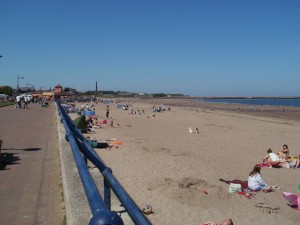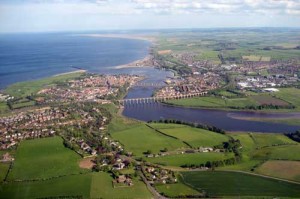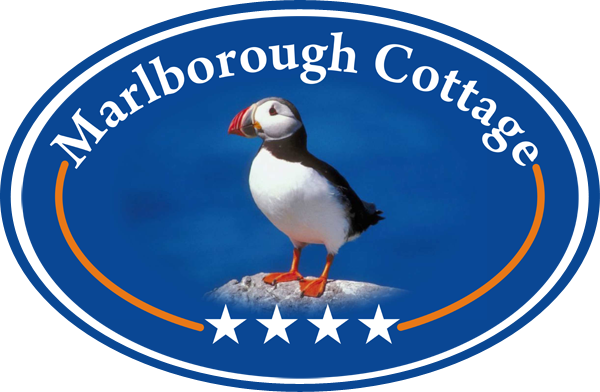
Spittal Beach and Promenade.
In 2015 Berwick celebrated it’s 900th. birthday. CLICK HERE for more information about the fascinating history of the Town.
BERWICK UPON TWEED is a fine, handsome and once very wealthy town. Steeped in blood-soaked history, and fascinating to explore, it is built upon a peninsula at the mouth of the Tweed.
Historically a commercial town, it faces the river, rather than the sea. Three bridges connect it with Tweedmouth on the south side of the estuary: the low stone bridge with 15 arches of varying height and width, completed in 1634; the 1928 concrete span known as the `Royal Tweed,’ and the railway’s `Royal Border’, with its 28 soaring arches, completed in 1850 and designed by Robert Stephenson. The town is best seen from the Tweedmouth bank or the railway bridge. Tweedmouth itself holds a feast on the Sunday after 18th July honouring St Boisil, a Saxon holy Man to whom the present St Bartholomew’s Church was dedicated at its founding in 1143. Today the `Salmon Queen’s’ coronation opens a week of events (well worth coinciding with).
Berwick sits on the north bank of the Tweed, at the east end of the long disputed border. It changed hands no fewer than 13 times until finally being snatched from Scotland by Richard III in 1482. The fortifications, started in 1558, make it one of Europe’s most outstanding fortified towns.
And so it should be; the staggering cost of nearly £130,000 constituted the single most expensive undertaking of the Elizabethan period. The defensive walls were built centuries earlier, during the reign of Edward II.
Within sight of the Ramparts stands Berwick Parish Church, the only Parish Church built during the Commonwealth of Oliver Cromwell (1599-1658).
Designed by John Young of Blackfriars, foundation stone laid 1650, opened in 1652, HOLY TRINITY replaced the medieval Church, which had stood a few yards to the south since 1190AD but demolished shortly after the new church was opened.
Fashioned largely from the stones and timbers of Edward I once Great 13thC Castle of Berwick-upon-Tweed, by then redundant following new defences by Elizabeth I, site and fabric have witnessed almost 1000yrs of history in good times and bad.
The barracks were constructed in 1717 in response to the first uprising by the Scottish Jacobites in 1715, and bear witness to the strategic importance of the frontier. Long before that, Berwick was a prosperous and occasionally peaceful Scottish `burgh’, having enjoyed a golden age during the 12th and 13th centuries, when it was a centre of European commerce, and had its own mint and royal castle.
This came to a spectacularly bloody end, when the area became so warlike that the monks on Holy Island spent more money on gunpowder than they did on parchment. The Scottish border, which had once reached as far south as Hull, changed radically once again. Lands were grabbed back in 1174, along with strategic castles at Berwick, Roxburgh and Edinburgh. Richard the Lionheart soon sold them back to the Scots to finance his crusades, but cross-border conflict rumbled on.
Edward I, `Hammer of the Scots’, decided to sort matters out once and for all by raiding and sacking Berwick on March 30, 1296. And `by his gracious power killed 25,700 people’, including all the Flemish and German wool and wine merchants who had helped build the town’s prosperity. To further stamp their authority, the English then displayed one quarter of the corpse of William Wallace (Braveheart) on a pike after he was executed in London in 1305. One assumes that Wallace Green was named after him.

Berwick upon Tweed from the air.
Berwick was, in terms of tax revenue, the fourth most important town in England by 1300. That is why it was so fought over. Robert the Bruce reclaimed it after Bannockburn in 1314 and it remained Scottish until 1333, after which the to-ing and fro-ing became such that, on occasions, both sides occupied different parts of the town at the same time.
There is some urban myth as well. Berwick was granted a special status as a free borough in 1502, and was mentioned separately in Acts of Parliament. Berwick was `of’, but not `within’ the Kingdom of England, thus documents were signed by England, Wales and Berwick-upon-Tweed. For this reason it was supposed still to be at war with Russia in the Crimea, having been specifically listed as declaring hostilities in 1854, but having been missed off the ensuing peace treaty two years later. This alarming state of affairs, though not supported by any historical evidence, was not resolved until the 1960s, when Khrushchev sent an emissary to the north east to put a formal end to the war. Current thinking suggests that this urban myth was perpetrated a century ago by a local Archdeacon with a sense of fun.

Berwick Swans.
A tour of the Barracks and the museum gives a wonderful insight, not only into regimental history, but also the town’s schizophrenic past. Originally home to the 25th Regiment of Foot, it was used as a staging post on the journey north, and became home to the King’s Own Scottish Borderers in the 1880s. It is still their regimental headquarters and to this day they flood the town in early August to commemorate the Batlle of Minden and parade through the town – a spectacular sight. A two kilometre walk around the ramparts, perhaps taking in a guided tour by Derek Sharman MBE our local historical expert, is a must.
Berwick is quite unique and can boast:
The Lowry Trail – a brilliant tour of art and imagery (click here to take the virtual tour)
Berwick Rangers, the only English Team to play in the Scottish Division
Berwick Bandits – Speedway
A yearly Riding of the Bounds
Over the years the town of Berwick has become home to the second largest mute swan colony in Britain. The swans are now such a familiar feature of the Tweed estuary that they have become a well-known tourist attraction, and at peak times almost 800 birds have been counted. The Berwick herd is known as a ‘moulting colony’, this means the numbers fluctuate throughout the year. There are around 200 permanent residents but the numbers increase in late summer and through the winter as swans arrive to undergo annual moult and feed the rich Tweed.
There is plenty to see and do in Berwick including:
Wednesday and Saturday High Street Market
Regular European, Dickensian and themed street entertainment and markets.
Maltings Art Centre (Eastern Lane) hosting, cinematic film, farmers market, plays, operatic society and other amateur productions, live music, comedy acts, bar and restaurant.
Food and Film festivals
See our events page for up and coming attractions and showcases.

